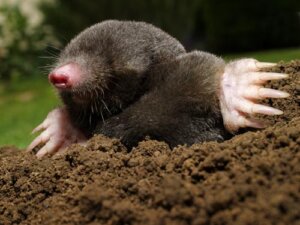Have you walked into your beautifully kept lawn and seen dirt mounts scattered around or unsightly raised patterns of grass and broken earth? If this scene sounds familiar, you have moles.
What are Moles?
Moles are small mammals that average seven inches in length and weigh four ounces. They have grey or brown furry bodies with very small, almost inconspicuous, eyes and ears. Two of their most distinguishing characteristics are a hairless, pink pointed snout and wide forefeet with large claws — perfect for digging.
Moles are ground–dwelling carnivores that prefer moist, loamy soil and eat earthworms, which make up about 90% of their diet followed, by grubs. They find their meals by feeling the vibration of earthworms moving through the soil. In motion, they actually swim along underground, using their wide forefeet to part the soil as they go.
Are Moles Dangerous?
Moles can create havoc in your lawn, creating 15-18 feet of tunnels per hour and traveling up to 80 feet per minute in existing tunnels. Raised volcano-shaped swellings of dirt are a sign of mole tunnels. Typically, the nicer your lawn is, the greater your chances of getting moles. Why? A nice lawn means good soil and good soil translates into lots of earthworms.
Are moles dangerous to humans? No. However, they are dangerous to the lawn and landscapes that they invade. They can cause costly damage to the root system of grasses and ornamental plants as they create their tunnels and forage for food.
Quick Facts
- While you mostly only see moles in the spring and fall, they are actually active year-round. These little mammals do not hibernate.
- Moles have a ravenous appetite, eating between 80-100% of their body weight every day.
- A mole’s saliva contains a toxin that can paralyze their prey and allow the mole to store it alive for later.
How do I get rid of Moles?
Contrary to popular belief, baits, sonic chasers, repellants, mothballs, and home remedies have no effect on moles. OPC will use an attractive and palatable bait called “Talpirid,” which is scientifically proven to kill moles. The bait is designed to mimic an earthworm that can be easily identified by the mole.
We use a 3-Step Process to treat your problem.
- Step 1: OPC will visit the property to map and evaluate the site to determine which runs are active.
- Step 2: OPC will revisit the site to place the bait which mimics the earthworm in the active runs.
- Step 3: Follow-up services will be performed to evaluate the results and determine if future baiting needs to occur.
Take Back Your Lawn! Contact us for a free inspection and estimate.
